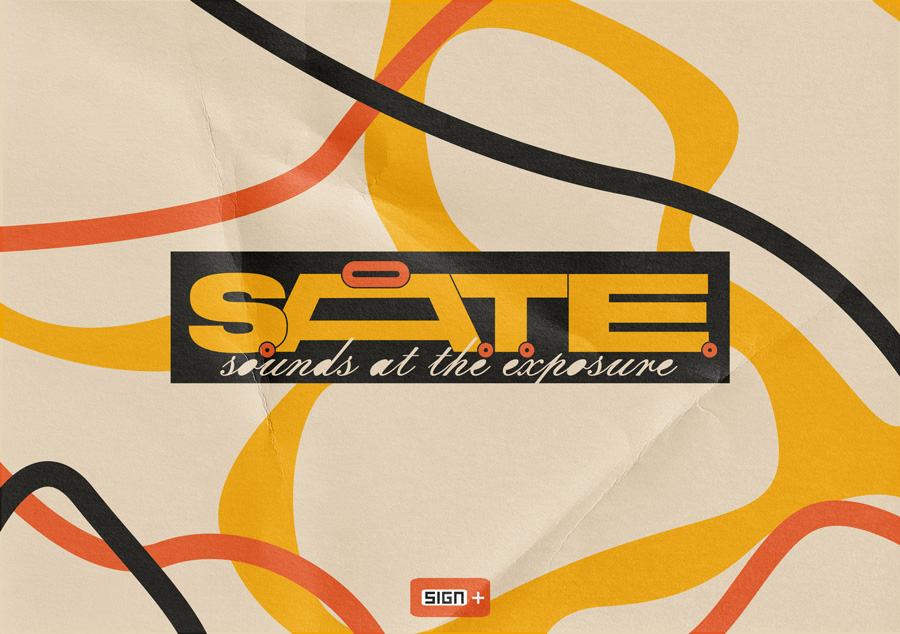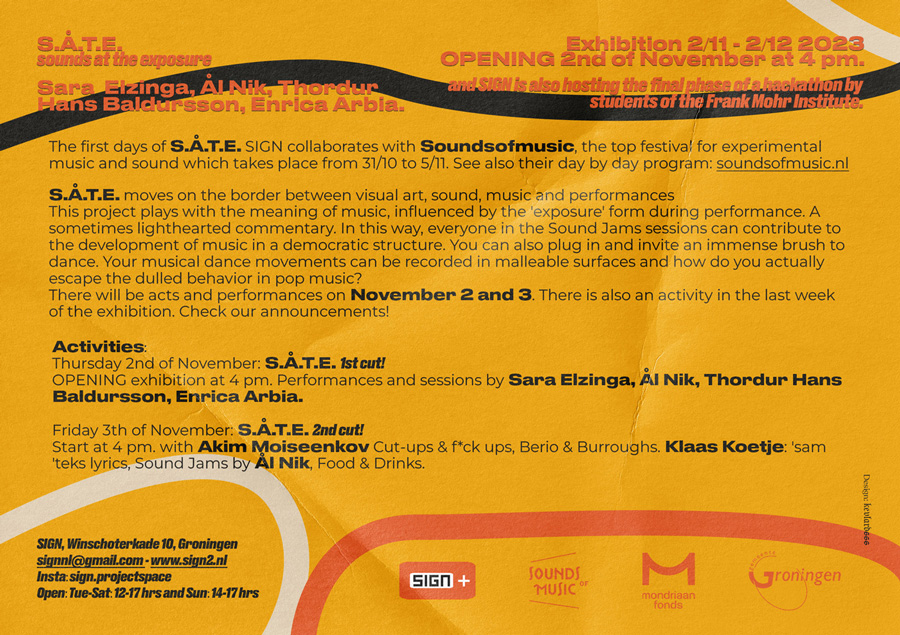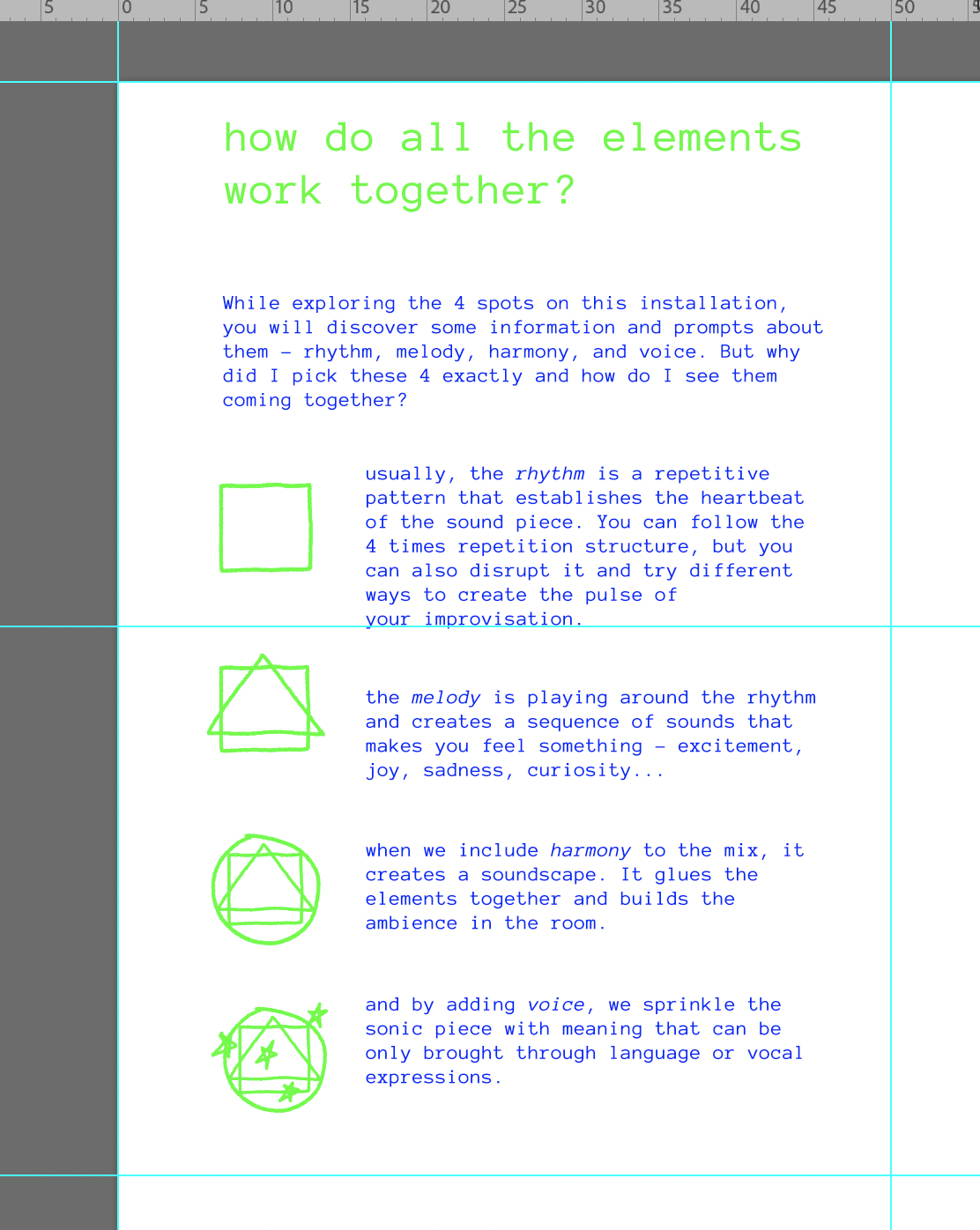Sound jams: sounds at the exposure: Difference between revisions
| Line 31: | Line 31: | ||
== <span style="color: white; font-family: Menlo; text-decoration:none; background-color: #0033ff; padding-top: 0.1vw; padding-bottom: 0.1vw; padding-left: 0.1vw; padding-right: 0.2vw;"> _build-up </span>== | == <span style="color: white; font-family: Menlo; text-decoration:none; background-color: #0033ff; padding-top: 0.1vw; padding-bottom: 0.1vw; padding-left: 0.1vw; padding-right: 0.2vw;"> _build-up </span>== | ||
[[File:Designing one of the general cards.png|thumb|designing one of the general cards: how do I imagine the four elements working together]] | |||
<span style="color: white; font-family: Menlo; text-decoration:none; background-color: #ff0033; padding-top: 0.1vw; padding-bottom: 0.1vw; padding-left: 0.1vw; padding-right: 0.2vw;"> '''prompts''' </span> As a major part of this work, the prompts were created carefully, after many iterations. I would like to thank Stephen Kerr for helping me with discussions about the instruments and the instructions, as well as his input during our editing session. | <span style="color: white; font-family: Menlo; text-decoration:none; background-color: #ff0033; padding-top: 0.1vw; padding-bottom: 0.1vw; padding-left: 0.1vw; padding-right: 0.2vw;"> '''prompts''' </span> As a major part of this work, the prompts were created carefully, after many iterations. I would like to thank Stephen Kerr for helping me with discussions about the instruments and the instructions, as well as his input during our editing session. | ||
Revision as of 22:25, 19 October 2023
_invitation
«s.å.t.e. - sounds at the exposure»
The show moves on the border between visual art, sound, music and performances. This project plays with the meaning of music, influenced by the ‘exposure’ form during performance. A sometimes lighthearted commentary. In this way, everyone in the Sound Jam sessions can contribute to the development of music in a democratic structure. You can also plug in and invite an immense brush to dance. Your musical dance movements can be recorded in malleable surfaces and how do you actually escape the dulled behaviour in pop music? There will be acts and performances on November 2 and 3. There is also an activity in the last week of the exhibition. With this project, SIGN also participates in the Soundsofmusic festival, the top festival for experimental music and sound.
Artists: Sara Elzinga, Ål Nik, Thordur Hans Baldursson, and Enrica Arbia.
_About my work:
With my new Sound Jam, part of the exhibition, I intend to create a cosy space for people to make sounds together. With the help of some visual invitations [prompts & visual scores], I propose the visitors to explore ways to make experimental music, noise and sounds inside the gallery and to disrupt the traditional playing in a band. Their stage is as cosy as a living room and the sound-making instruments and objects are accessible and fun. This interactive installation invites the guests to explore some traditional music-making elements and to disrupt them. To have conversations about how to approach the collective making. And also to experiment and try out ways to do it in a different way.
opening: 2-11-2023, 4pm CET exhibition runs: from 2-11 until 2-12-2023 SIGN project space Winschoterkade 10 9711 EA Groningen
_context
During the first days of our exhibition, SIGN collaborates with Soundsofmusic, a festival for experimental music and sound. The context of my work for this show comes from the invitation to become part of an experimental music-making process and I wanted to create a space where the visitors of the festival, and the exhibition, can become makers, too.
Since my previous Sound Jams focused on the process of creating a safe space and making it accessible for people from different backgrounds, I wanted to continue that fundamental line of work in this one as well. I asked myself questions like "how can a person without musical training approach experimental music-making?" or "how can I invite a person with technical experience to let go of it and simply play at my installation?". The interactive space I am building had to be able to accommodate some information and prompts to support the visitor in the process of exploring how to make it happen - how to sound jam. It also had to give appropriate and accessible sound-making objects, many of which should be easy-to-use musical instruments. In order to make it less scary, it should be acoustic - I should limit the possibility of microphonics, or other scary and disturbing situations within the technical setup. I wanted the space to be welcoming, cosy, warm, and chill. It should make you feel comfortable enough to stay there, read, explore, try out things, experiment, and connect with others. How to create opportunities for the visitors to experience things but not limit them too much with strict instructions?
_build-up
prompts As a major part of this work, the prompts were created carefully, after many iterations. I would like to thank Stephen Kerr for helping me with discussions about the instruments and the instructions, as well as his input during our editing session.
The prompts are divided into two big groups: there are the introductory ones that are placed at the entrance of the installation; and also specific ones on each of the four stations with sound-making objects. The general prompts give info about the whole setup and how to navigate in it. They also help the visitor with some ideas on how to start jamming, how to join if there are people playing already etc. Here I also explain why I created four stations at the installation. There are also 4 sub-groups of prompt cards placed on each station: rhythm, melody, harmony, and voice. There is a short intro giving a brief explanation of what these 4 elements mean (and to me). There are also cards with ideas on how to play with particular instruments and ideas on how to disrupt them.
prompt stands
sound-making objects & instruments
space
_installation setup
_sessions
_publications
_colophon
_references & further reads
★ Cardew C. (ed.), (1969). Nature Study Notes. Scratch Orchestra, Experimental Music Catalogue.
★ Cardew C. (1971). Towards an Ethic of Improvisation. Treatise Handbook Edition Peters
★ Mathieu, W.A. (1991). The listening book : discovering your own music. Boston: Shambhala.
★ Toop, D. (2016). Into The Maelstrom: Music, Improvisation and the Dream of Freedom. Before 1970. New York: Bloomsbury Academic.
★ Yōko Ono (1971). Grapefruit. New York: Simon And Schuster.


